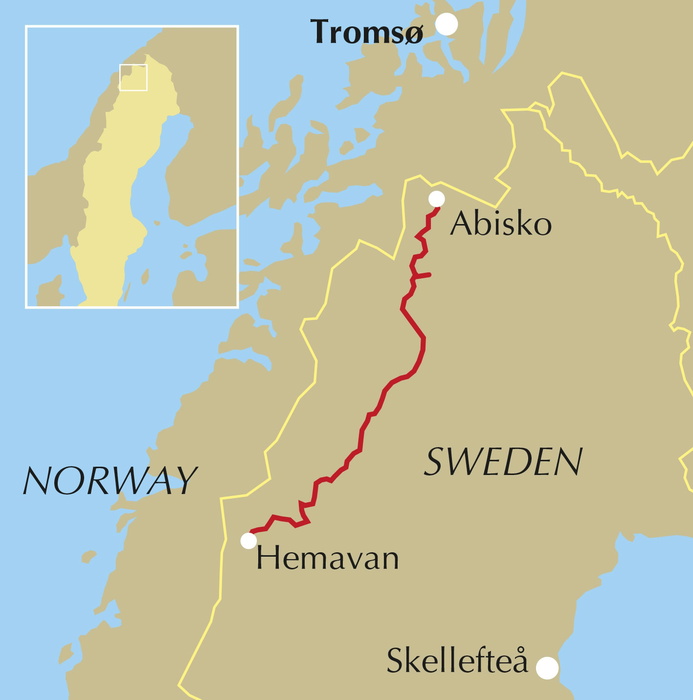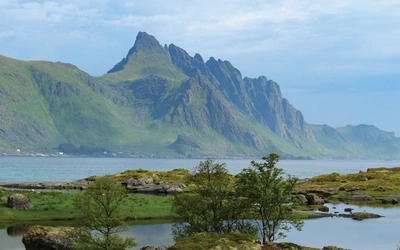An introduction to the Kungsleden Trail
The Kungsleden is as varied as the vast Arctic wilderness, traversing snow-topped mountain ranges, expansive open fell, verdant forests and crossing lakes both large and small. Lying mostly within the Arctic Circle, the 460km route can be walked in shorter sections if preferred and even includes an optional ascent of Kebnekaise, Sweden's highest peak. Here's what you need to know.
Trekking the Kungsleden
The King's Trail through Northern Sweden
£18.95
Guide to the Kungsleden (King's Trail), Sweden's premier long-distance trek. Lying mostly within the Arctic Circle, the 460km route across Lappland is presented in 28 stages but can be walked in shorter sections if preferred. Includes an optional ascent of Kebnekaise, Sweden's highest peak, plus notes on huts and wild camping.
More information
Where is the Kungsleden Trail? Is it the same as the Kings Trail?
The sub-arctic landscape of Northern Sweden – the 460km trail begins at Abisko and heads south to Hemavan. For half its length, the Kungsleden, also known as the Kings Trail, lies within the Arctic Circle, and consequently, a large measure of the summer walking season takes place in 24-hour daylight. This is also Sápmi, home of the Sámi people, whose close relationship with the reindeer has underpinned their existence since the last ice age. The reindeer are mostly absent during the walking season, although the Sámi are evidenced by their summer villages, their traditional dwellings (kåtor), reindeer enclosures (rengärden) and remote huts.
Where does the trail start and end?
The trail traditionally starts in Abisko and heads south to Hemavan in five continuous yet distinct sections, meaning some hikers can opt for shorter sections. The most popular stretch is between Abisko and Nikkaluokta, covering about 105km (65 miles) in the northernmost section.
How long does it take to walk?
The average walker usually takes between four and five unhurried weeks to complete the entire trail. The Kungsleden is suitable for hikers of various experience levels. The trail is well-marked and signposted throughout, with no technical climbing involved. However, it requires good fitness due to long distances, uneven terrain, and unpredictable weather.
When is the best time of year to walk the trail?
The best time to hike is from mid-June until the end of September. The weather is relatively mild during this period, and the trail is snow-free. You’ll experience the midnight sun in June and July, while September offers fewer crowds and vibrant autumn colours.
Which direction is the trail best walked in?
Most walkers, especially those through-hiking, travel from north to south along the trail. This is a particularly good choice if you are walking at the season’s end, as winter comes sooner to the north than it does to the south. Southwards is also the manner in which the Kungsleden evolved over time and it seems a natural and popular way to travel. Walking northwards has its merits, especially at the season’s start and, for the reverse reasons stated for heading south at the season’s end. Heading northwards will place the sun at your back, aiding photography and maximising the efficiency of any solar charging device being carried on your rucksack. Finally, those walking northwards are more likely to find two rowing boats waiting for them at crossings and are, therefore, less likely to make three crossings to return a boat.
What accommodation is available?
The entire landscape is a paradise for wild campers, although three of the five sections are furnished with regular Swedish Tourist Association (STF) mountain huts or fjällstugor. Volunteer wardens man these huts and provide a host of facilities that include bunk bed accommodation, wood-fired saunas, basic supplies, a shop, weather forecasts and cooking/dining areas; wild campers can also use these facilities on a ‘day visitor’ basis as they pass through. Those staying at the huts are expected to assist with housekeeping tasks such as fetching water, disposing of wastewater (or Slask) and chopping wood; however, the burden is never onerous.
Allemansrätten allows the public to camp overnight and, with the exception of the Abisko National Park on Stage 1, you are at liberty to wild camp anywhere along the Kungsleden. Those choosing to camp will enjoy maximum freedom on the trail but still be able to use fjällstuga facilities for bastu (sauna), as day visitors pass through, for resupply, camping or even sleeping inside occasionally. Good camping is not found everywhere; forests generally provide limited camping opportunities.
What about practicalities like food and transport?
Transport and resupply require some forward planning as the Kungsleden traverses a remote landscape where settlements are scattered and small. Purchasing food and stove fuel at the huts on the sections that have them will minimise rucksack weight but will be relatively expensive, and choice will be restricted. It is possible to resupply at section ends, which will prove more economical. Swedish society is almost cashless and cards are accepted virtually everywhere, save at the remotest of the STF huts. Local transport services are limited, and if you are entering or exiting anywhere other than Abisko and Hemavan, it can take up to two full days of travelling to reach a major airport such as Stockholm.
The Kungsleden has a reputation for being challenging to access and travel around, and to some extent this is true given the region's remoteness. Walkers are advised to research their travel options fully as onward connections in more remote areas are not always daily or frequent. While the Kungsleden’s extremities at Abisko and Hemavan are readily accessed, getting to and from the intermediate sections is more complex and requires careful research. Those planning will face the greatest transport challenges to walk non-consecutive sections, while through-hikers will benefit from very good transport links at their start and finish.
What about boat crossings?
Several boat crossings are along the Kungsleden Trail, particularly in the northern and central sections. Notable crossings include Teusajaure Lake in the Abisko to Nikkaluokta section and Laitaure Lake near Aktse in the central part of the trail. These crossings offer either a motorboat service or a rowboat system. The rowboat system, provided by the Swedish Tourist Association (STF), typically involves three boats – one on each shore and a third for returning boats to the starting side. If no boat is on your side, you’ll need to row across, fetch a second boat, and return it before continuing, which can be time-consuming. Motorboat services, where available, charge a fee, often payable in cash or via Swish, and operate during the hiking season (mid-June to mid-September). Walking around the lakes is generally impractical due to the distance and terrain, so most hikers will need to use the boats. It’s important to plan ahead, check schedules, and be prepared to row if motorboats aren’t available.
What wildlife might I see?
If you are lucky you may spot otters beside the rivers, moose in the marshy river deltas, white-tailed eagles soaring overhead or peregrines diving from cliffs on high. Sweden’s ‘Big Four’ are the brown bear, wolverine, lynx and wolf; all are wary of humans and are unlikely to be seen. Reindeer are largely absent in the summer, migrating westwards to the higher, cooler grazing on the Norwegian border.
Why should I walk the Kungsleden Trail?
The trail's location above the Arctic Circle offers a unique experience, including 24-hour daylight in summer and stunning views of the Northern Lights in autumn. The route passes through several national parks and Europe’s largest nature reserve, Vindelfjällen.
Trekking the Kungsleden
The King's Trail through Northern Sweden
£18.95
Guide to the Kungsleden (King's Trail), Sweden's premier long-distance trek. Lying mostly within the Arctic Circle, the 460km route across Lappland is presented in 28 stages but can be walked in shorter sections if preferred. Includes an optional ascent of Kebnekaise, Sweden's highest peak, plus notes on huts and wild camping.
More information











